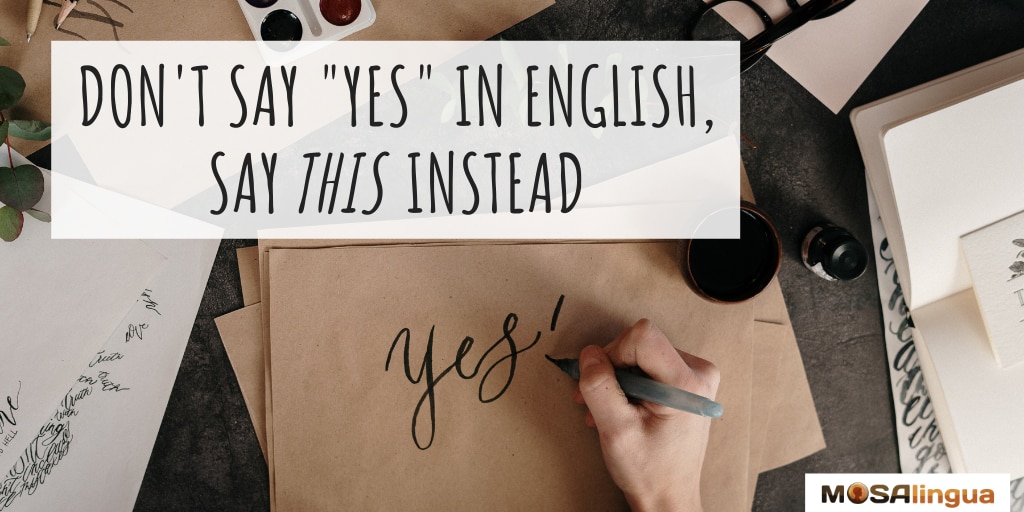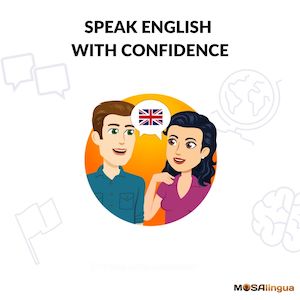Are you hoping to enrich your English vocabulary? Today, I’m going to talk about a word that you probably use a lot. In fact, it’s THE most common way to express agreement or affirmation in English: “yes!” What’s wrong with saying “yes” in English? Nothing, it’s just that there are many different ways to say “yes” in English that are more nuanced and have the benefit of making you sound more advanced. You don’t want to look like a beginner your whole life, do you?

You can also listen to this article via our MosaLingua Language Lab podcast:
Listen to “#46 – Don’t Say “Yes” in English” on Spreaker.
What’s inside…
Alternatives to “Yes” in English: Casual and Formal Options
The idea of this article is to help you learn English by changing your reflexes. There’s a fun game I sometimes play with my students. You can even play it with your friends! It’s easy: have a back-and-forth exchange with a friend or conversation partner, asking each other questions. The only rule is that you aren’t allowed to say “yes” or “no.” It’s basically the opposite of 20 Questions, where you can only answer with yes/no! It forces you to be creative with your answers and really helps you improve your speaking skills.
The most casual phrases
If you’d like to try this at home, here are some very simple and informal synonyms of “yes” that you can use if someone asks you a standard yes/no question:
- Mm-hmm
- Uh-huh
- Yep / Yup
- Yeah
- Sure
- For sure
- Totally
🗣 MosaTip: To learn how to pronounce sounds like “mm-hmm” and “uh-huh” like a native speaker, watch the video at the end of this article! You might also like our complete guide to English pronunciation.
If someone asks you to do something, for example,
– “Can you feed my cat while I’m on vacation?” 🐈
…instead of saying “yes,” you could say:
- You got it!
- You bet.
- Sure thing!
- Ok. / Okie Dokie.
Again, these are very casual responses, so we recommend that you avoid using them in any kind of formal conversation.
Improve your spoken English

Good news: we have a course for that: the Speak English with Confidence MasterClass.
It’s a comprehensive 10-module course designed to help you improve every aspect of your spoken English – fluency, confidence, pronunciation, and more – step by step, and enjoy doing it.
The most formal phrases
Other synonyms of “yes” in English are more appropriate for professional contexts:
- Of course
- Certainly
- Definitely
- Absolutely
And if someone asks for clarification, for example,
– “Is it your birthday tomorrow?” 🎂
…you can respond by saying:
- That’s correct.
- That’s right.
- It sure is!
The most fun phrases
And here are a few “fun” ways to say “yes”:
- Roger (that)
- Copy (that)
These expressions are mostly used by pilots (you may have heard them in the Apollo movies) to confirm that they have received a message. Here’s another option:
- Affirmative
Again, this one is primarily used in the military, but any native speaker will understand it.
Ideally, Speak in Complete Sentences
These are all good replacements, but what’s even better is coming up with a full sentence as your answer. That might remind some of you of your language teachers in grade school, who yelled at you when you answered the questions they asked in class with “yes” or “no.” Like I said earlier, they did that because they wanted to push you to improve your speaking skills.
But there are at least three other good reasons why you should make a habit of answering with full sentences:
1. To show that you’re listening
Reformulating the question shows the person you’re talking to that you listened attentively to them and understood what they said. This is especially important if you are being given instructions, for example.
Your answer can simply include the same information from the question, reformulated as an affirmative. Or you can add new information that makes your answer clear. You can even reply with another question, to clarify or get more information.
For example:
– “Have you been to the dentist recently?”
– “I went to the dentist last week. No cavities!” 😁
2. To make your answer more clear
Rewording also eliminates the possibility for confusion and ambiguity. In English, the way some yes/no questions are asked makes them quite confusing. Here’s an example: “You didn’t go to the party?” If you answer “yes,” does that mean yes, the speaker is correct, you did not go to the party? Or does it mean yes, you did in fact go to the party? Other languages have specific words to deal with situations like this, but in English, you have no choice but to expand to make the meaning clear.
Here’s another example:
– “Do you like Mexican food 🌮 or Indian food 🍛?”
This could be a yes/no question. If you answer “yes,” it probably means that you like both types of cuisine, and if you answer “no” it probably means that you like neither. But the person asking the question might mean it as a choice question and be expecting you to state your preference between the two.
By the way, native speakers can usually tell which type of question is intended by the intonation with which it is asked, but this can be trickier for learners.
3. To keep the conversation going
Finally, providing more information helps keep a conversation moving, if you want it to. Answering someone’s questions with a quick “yes” or “no” can make it seem like you don’t want to keep talking, even if you do! It’s an opportunity to show your personality, for example, if someone asks,
– “Do you like baseball?”
You could answer, “Yes.” Or, you could answer,
– “I watch every single Cincinnati Reds game on TV and I attend at least two games a year.” ⚾️🧢
This way, your conversation partner won’t have to keep asking questions based on your one-word answers.
Video Tips: What to Say Instead of “Yes” in English
Now that you know a few alternatives to saying “yes” in English, have a listen! You can also hear their correct pronunciation. You can find all the contents of this article in our YouTube video below. Or you can watch it on our channel. You can turn on subtitles or slow down the playback speed if you need to by clicking on the gear (⚙️) at the bottom right.
Subscribe to our YouTube channel to learn more English expressions
Take It Further
Now you’re perfectly equipped for the game I mentioned at the beginning of this video. Try it out and leave a comment on this video to let me know how it goes!
Would you like to learn even more English vocabulary? You might be interested in these other articles, too:




Comments